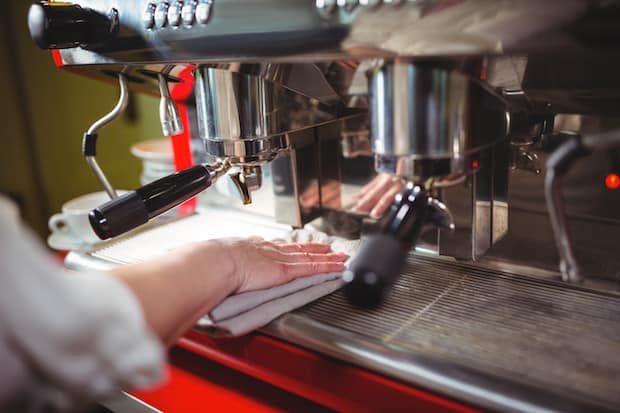Last Updated on December 13, 2023
Cleaning your espresso machine is essential to creating the best-tasting coffee. Even a slight buildup of residue can give your coffee an off -putting taste.
You should clean your machine thoroughly every day, complete an occasional deep cleaning, and do annual maintenance.
Cleaning your espresso machine throughout the day
For cleaning during multiple uses, make sure you:
1. Wipe and purge steam wand
Wiping the steam wand helps to get rid of any residue from the last use. Purging the wand helps get rid of obstructions at the tip. Doing these two steps helps prevent bacteria from collecting and getting into your espresso drinks.
2. Flush brew head
The brew head is the part that shoots water out into the filter basket. Make sure to do flush it after each round of espressos. Buildup can occur in this area from the old batch and add a funky taste to your espresso.
Make sure your cleaning cloths are clean. Since the wand and other parts are wiped down after use, the cloths must be able to remove gunk, rather than adding more. We recommend replacing the cloths at least two or three times a day if you’re making a lot of espresso.
If you are only making one round of espressos at home, you can skip these steps.
Cleaning your espresso machine at the end of the day
Espresso machines should always be cleaned at the end of the day. Make sure you:
- Complete a backflush and scrub the brew heads with a machine brush. This helps loosen and get rid of any coffee grounds that might remain. Use the detergent recommended by the manufacturer and make sure you run the water until it comes out clear. If you want to be absolutely sure the detergent taste is gone, pull a couple of espressos in the morning before serving any again.
- Clean and soak the wand in water and detergent.
- Clean the draining hose to prevent any clogging or buildup.
- Make sure to clean all the other components such as filter basket, and drip tray to make sure there are no grounds remaining.
Deep-cleaning your espresso machine
Deep cleaning should be done occasionally.
- Switch out the filter basket and screens to make sure there are no leaks.
- Check the water quality. Harder water with more minerals in it can calcify your water tank. Depending on the water quality, you may want to consider descaling.
- Some parts may need to be replaced yearly, depending on use. Even if they aren’t broken, replacing parts can make your machine run more smoothly. Check and replace:
- The rings on the steam or hot-water valve. They can wear out over time.
- Shims on the shoulder bolt.
- Expansion valve. This part is important for preventing leaks and cooling the water in your tank.
- Bearings and pipes. After long-term use, buildup and wear can start to affect the taste of your coffee.
While it may seem like there’s a lot of maintenance, this is important stuff—especially if you’re using the machine to serve customers or making a lot of espresso at home. It’s important for the longevity of your machine and for the taste of your coffee.
As for cleaning products, the manufacturer should recommend whatever works best with their machines. It’s wise to follow these, because different coffee machines are made of different materials that require different solutions or products.
You can also use vinegar to clean your machine. While this may be effective, it can also leave a vinegary taste, so make sure to rinse well.


